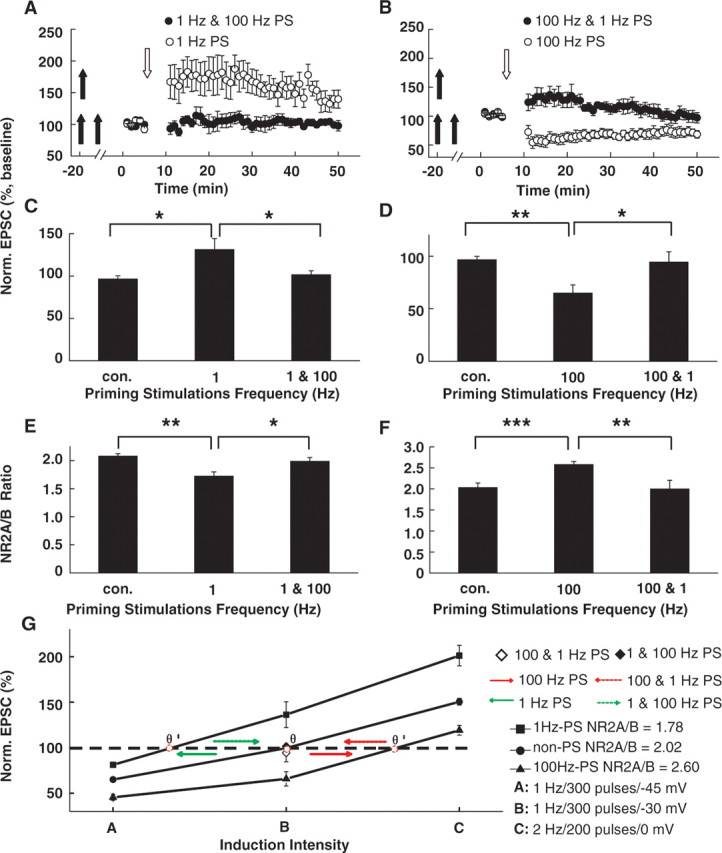Figure 5.

Sequential PSs bidirectionally regulate the NR2A/NR2B ratio and LTP/LTD threshold. A, The effect of 1 Hz LPS on subsequent LTP induction was reversed by the interleaved 100 Hz HPS. Treatment with 1 Hz LPS alone led to the emergence of LTP produced with the threshold protocol. However, the threshold protocol failed to produce LTP after 100 Hz intervened between 1 Hz LPS and threshold protocol stimulations. Double filled arrows refer to sequential PSs at different frequencies delivered at different time points. Open arrows refer to the time points when the threshold pairing protocols were applied. B, The effect of 100 Hz HPS on subsequent LTP induction was reversed by the interleaved 1 Hz LPS. The 100 Hz HPS alone led to the emergence of LTD produced with the threshold protocol. However, the threshold protocol failed to produce LTD after 1 Hz intervened between the first priming and threshold protocol stimulations. C, D, Statistical plot of averaged data showing normalized EPSCs examined after sequential PSs as a function of PS frequencies. The interleaved 1 Hz PSs reversed the effects of the former 100 Hz, and vice versa. *p < 0.05; **p < 0.01; ANOVA post hoc LSD test versus control. E, F, Statistical plot of averaged data showing the normalized NR2A/NR2B ratio as a function of PS frequencies. *p < 0.05; **p < 0.01; ***p < 0.001; ANOVA post hoc LSD test versus control. G, Summary plot showing bidirectional shifting of the θLTP/LTD after sequential PSs at different frequencies. Without PSs, the NR2A/NR2B ratio at the time points of LTP/LTD induction was 2.02. LTD and LTP induction protocols (stimuli A and C) could produce persistent depression and potentiation, respectively. Stimuli B, which was also referred to as the threshold protocol and was used to induce the θLTP/LTD response, failed to induce any persistent change. The 1 Hz priming LPS decreased the NR2A/NR2B ratio to 1.78. Accordingly, the threshold protocol produced LTP, indicating that the θLTP/LTD shifted to the left. Conversely, 100 Hz HPS increased the NR2A/NR2B ratio to 2.60. As a result, the θLTP/LTD shifted to the right. Sequential PSs of 1 and 100 Hz led the θLTP/LTD to slide back to the no-priming control position, as did sequential PSs of 100 and 1 Hz. The red spot refers to the position of the θLTP/LTD. Norm., Normalized; con., control.
